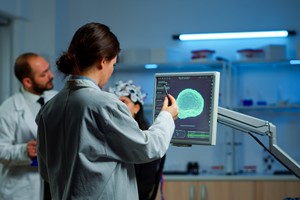Identification of risk factors for Parkinson's disease (PD) is essential for early diagnosis. Dating back to the 1920s, Parkinson's disease and parkinsonism -- an umbrella term that refers to motor symptoms found in Parkinson's disease and also other conditions -- have long been described in boxers. Repetitive head impacts from tackle football can also have long-term neurological consequences like chronic traumatic encephalopathy (CTE). But research on the association between participation in tackle football and PD is limited.
In the largest study to describe the association between participation in football and the odds for having a reported diagnosis of PD, researchers from the BU CTE Center used a large online data set of people concerned for having PD and found participants with a history of playing organized tackle football had a 61% increased odds of having a reported parkinsonism or PD diagnosis.
In this study, the researchers evaluated 1,875 sport participants -- 729 men who played football, predominantly at the amateur level, and 1,146 men who played non-football sports who served as the control group. Participants were enrolled in Fox Insight, a longitudinal online study of people with and without PD sponsored by The Michael J. Fox Foundation for Parkinson's Research.
Notably, researchers found a link between playing football and increased odds for having a parkinsonism or PD diagnosis even after accounting for known risk factors for PD. Additionally, the data revealed that players who had longer careers and played at higher levels of competition experienced increased odds for having a reported diagnosis of parkinsonism or PD. Football players who played at the college or professional level were at 2.93 increased odds for having a PD diagnosis compared with those who just played at the youth or high school level. Age of first exposure to football was not associated with odds for having a reported parkinsonism or PD diagnosis.
"Playing tackle football could be a contributing risk factor to PD, particularly among people already at risk due to other factors (e.g., family history). However, the reasons for this relationship are not clear and we also know that not everyone who plays tackle football will develop later-life neurological conditions, meaning many other risk factors are at play," says corresponding author Michael L. Alosco, PhD, associate professor of neurology at Boston University Chobanian & Avedisian School of Medicine.
The researchers also emphasized that they compared the football players to another group of athletes, a noteworthy strength of the study. Furthermore, most of the participants played tackle football only at the amateur level, which is contrast to most of the research to date that has focused on professional athletes.
"Previous research has focused on the association between American football and risk for CTE. However, similar to what has historically been seen in boxers, American football might also affect risk for other neurodegenerative conditions such as PD," says Hannah Bruce, MSc, first author and research specialist at Boston University Chobanian & Avedisian School of Medicine.
The researchers acknowledge several limitations to their findings and caution that the work is still preliminary. It was a convenience sample of people enriched for having PD who were mostly white, thereby limiting the generalizability of the findings. Diagnosis of PD was also self-reported by participants through online assessments and objective in-person evaluations were not conducted.
This work was in collaboration with The Michael J. Fox Foundation for Parkinson's Research, the sponsor of Fox Insight. The Fox Insight study was used to collect and aggregate data used in this manuscript. Grant funding was also from NINDS (U54NS115266; K23NS102399).
By: Boston University School of Medicine










